
I tried removing the EEPROM but the bridge will not function without it. When attempting to eject the drive, it’s clear that the EEPROM probably contains many default values as the device name does not seem to have been customised at all. I would not recommend this device at all purely because it fails to achieve its promised claims of UASP and USB 3.0. This implies to me that there is something really marginal with the implementation of USB 3.0 connectivity on this device. The only way to use it without such failures was to use USB 2.0 only. Two different 2.5″ drives were tried, along with different cables and an Intel based machine with no differences – it was absolutely impossible to use the enclosure stably in USB 3.0 mode.

The enclosure does not remain connected, however, while writing and instead drops out. While testing the read-back on my AMD-based system using an SSD in the enclosure, readback is punctuated by numerous sharp dips in the activity where the enclosure stalls during data transfer. The first disappointment was when connected, it was detected with VID 2109, PID 0711 and REV 0144 but was only a USB Mass Storage Device and not detected as a UASP capable device. It is supplied with a USB 3.0 cable that is marked UR AWM 20275 80C 30V VW-1 E318233 Kaibao Wire High Speed USB Cable Revision 3.0. The PCB does not have much in the way of components on the underside. This is supported by a Puya P25D21H 2Mbit EEPROM. The bridge-board uses a VL711S chipset, date coded Week 36 of 2016. The PCB is marked CS-711CB-190610 indicating the design is fairly recent. The fit is fairly tight, which is good.Įven the bridge-board is only “wedged” into the enclosure, with no screws. The design is completely tool-less with the case wedging into the internals without the use of screws. The case is tool-less, being opened simply by prying it apart.Ĭonnections are by microUSB-B with an activity indicator LED. The case itself is relatively anonymous, featuring only the SATA logo and text saying USB 3.0 on one side. The first to arrive was a cheap, flimsy-feeling, matte-black plastic enclosure. After all, there’s nothing too complex about a USB 3.0 to SATA enclosure, right? Product 1: Black Enclosure Both advertised UASP support, so I figured they should do the trick. Better than letting them idle, I thought it would be good to shove them into a USB enclosure for use as an external storage device, so I went shopping for some enclosures.įeeling thrifty, I tried two different varieties from the “low-cost” end of eBay, one which was black (AU$6.59) and the other which was transparent (AU$8.40).

I’ve almost always got an excess of computing equipment, which includes spare 2.5″ hard drives and smaller SSDs.


 0 kommentar(er)
0 kommentar(er)
